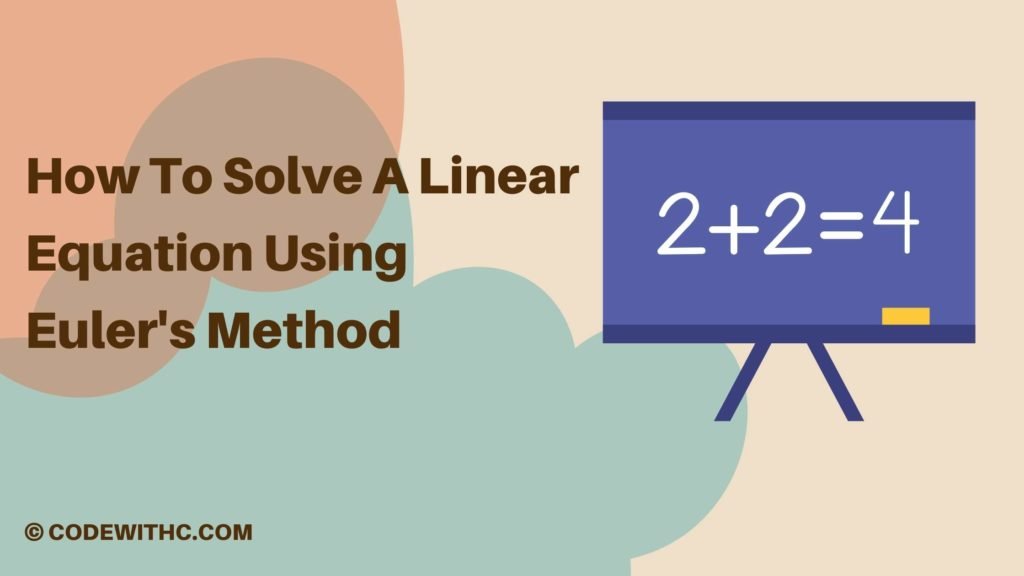How To Solve A Linear Equation Using Euler’s Method
Several questions appear in different competitive exams like JEE and NEET, and most of them are related to algebra. So, today I am going to discuss the concept of a linear equation and solve them using the Euler method. Solving the equations in mathematics is one of the easiest ways to earn good marks in exams. There are different types of questions in the math section of the exams, and most of the questions are related to algebra.

In mathematics, a linear equation is a statement that two quantities are equal. Let us take an example of the given equation x + y = 7.
Step 1:
We need to understand the given equation is equal to what? The answer is that it is equal to 7.
Step 2:
Now, let us break the given equation into individual terms.
Step 3:
The first term is x, and the second term is y, which means x + y = 7.
Step 4:
Now, we will use the addition property to simplify the equation.
Step 5:
x + y = 7
Step 6:
To simplify the equation, we will use the distributive property.
Step 7:
x + (y – x) = 7
Step 8:
By solving the above equation, we will get x = 3 and y = 4.
Euler’s Method and the technique of proof by contradiction
Mathematics is a language that we use everywhere in our lives. We use it in various aspects of life. Math is the science of numbers and ratios. We need maths in our everyday life because without math we won’t be able to understand and use the concepts of time, length, area, volume, and more. We need mathematics for the measurement of things and the calculation of things.
Math is the most important and basic topic in the school curriculum. Students who master the topics of math will be able to perform well in the rest of their studies. This article is all about the basics of mathematics. In this article, we will learn how to solve equations using Euler’s Method and the technique of proof by contradiction.
Let’s begin with the simplest equation:
3x + 7 = 12
You will need to know that when you are solving an equation, you will be dividing one side of the equation by the other. So, we will divide both sides of the equation by 3, so that we can simplify the equation to:
2x + 2 = 6
We will multiply both sides of the equation by 2 and then we will add the values on both sides to get:
4x = 16
Then, we will subtract the right side from the left side to get:
x = 8
As you can see, the answer is 8. You can now verify that it is correct by checking the answer.
But there is a problem. What if you don’t know the value of x? In that case, you will have to use another technique. Let’s try it:
First, you will need to simplify the equation. As you can see, you have to simplify the equation by multiplying the whole equation by -1, and then you will have to add the values of both sides to get:
3x – 7 + x = 12
Then, you will divide both sides by 3. You will then subtract the right side from the left side to get:
2x = -6
Now, we will multiply both sides by 2.
You will then add the values of both sides to get:
4x = -16
Then, you will divide both sides by 4.
You will then subtract the right side from the left side to get:
x = -8
Now, you will check that this is the correct answer. If it is correct, then it means that you can solve any equation using this technique.
This is a very basic example of how you can use this technique to solve an equation. There are several different ways in which you can solve an equation. One of the most popular techniques is Euler’s method. Let’s learn how to solve an equation using this method.
In conclusion, A numerical technique is a method of calculating a solution to an equation. The method that we use for solving equations is called Euler’s Method. Euler’s method is a generalization of the simple Newton-Raphson method that solves linear equations. However, the most common application of Euler’s method is to find the roots of nonlinear equations. You may want to try Euler’s Method when you have a system of linear equations (e.g. 2x – 1 = 0). If you want to learn more about solving equations using Euler’s method, read about the basics of this technique in our guide here







